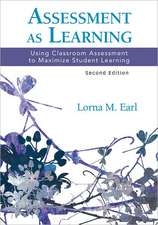The Principal as Curriculum Leader: Shaping What Is Taught and Tested
Autor Allan A. Glatthorn, Jerry M. Jailall, Julie K. Jailallen Limba Engleză Paperback – 15 noi 2016
The authors re-examine the key issues that continue to influence principals in the "real world", and include examples of ways principals can incorporate curriculum leadership into their organizational behaviour. This book will guide principals in working with teachers to generate meaningful curricula which will raise the level of learning – and teaching – in your school.
Preț: 291.33 lei
Nou
55.75€ • 60.54$ • 46.83£
Carte disponibilă
Livrare economică 01-15 aprilie
Livrare express 18-22 martie pentru 35.19 lei
Specificații
ISBN-10: 1483353117
Pagini: 288
Dimensiuni: 152 x 229 x 18 mm
Greutate: 0.45 kg
Ediția:Fourth Edition
Editura: SAGE Publications
Colecția Corwin
Locul publicării:Thousand Oaks, United States
Recenzii
"As principals, we so often get caught up in the day-to-day management of our schools. We must quit putting out fires and instead focus our attention on leading, specifically as curriculum leaders. Glatthorn, Jailall and Jailall provide a clear framework with a plan of action to put you and your school on a path to student success. Whether you need to develop a plan or simply refine the one you have, this book is a must read!"
"Glatthorn, Jailall, and Jailall challenge principals to be leaders of curriculum in their schools, districts, and states as they consider the needs of students and classrooms during a challenging time in education systems across the country."
"The Principal as Curriculum Leader is a blueprint for principals to use when implementing curriculum reform. It brings clarity to the many trends, mandates, and guidelines that masquerade as simple solutions to complex issues. This book should be read and owned by every principal and curriculum leader."
"An effective school requires a strong curriculum and high quality execution in every classroom. This can only be achieved when the principal becomes a true curriculum leader. Aspiring administrators and experienced principals will do a better job leading their schools after reading this powerful and practical book."
"The Principal as Curriculum Leader provides insight and practical suggestions to support the principal’s role as a building curriculum leader. This is a must-read guide that outlines the building administrator’s role as is relates to curriculum development, implementation and the impact an effective leader can have on instructional change."
"The Fourth Edition of The Principal as Curriculum Leader: Shaping What is Taught and Tested is the most comprehensive guide I've seen to assist all principals in moving from school managers to true 21st century instructional leaders. Glatthorn, Jailall, and Jailall have masterfully integrated ESSA and the revised Professional Standards for Educational Leaders, weaving those tenets into how school districts not only design relevant curriculum plans, but fully implement and assess how those plans are working. This is a must-read text for any school leader who is passionate about strengthening curriculum to raise the level of achievement for all students."
"As the school’s leader, the principal must accept responsibility for curriculum leadership. This book provides a toolkit of ideas, resources, and practical applications that should empower and enrich the principal’s professional life. It clearly provides guidance in improving curriculum design, implementation, and evaluation. Probably most importantly, the book emphasizes the collaborative, respectful relationship that should exist between the principal and the teachers within the school. A key take-away is that education is everyone’s business—from resource allocation by political leadership to expectations of parents—as our country educates its children for the 21st century."
Cuprins
Acknowledgments
About the Authors
PART I: Laying the Foundations
1. What It Means to Be a Curriculum Leader: Post Race to the Top, the Era of the Common Core of State Standards (CCSS) and the Every Student Succeeds Act of 2015 (ESSA)
Movement Toward National Standards
Influences on Curricula: Current and Past
The Hallmarks of Curriculum Quality
Chapter Summary
References
2. Some Current Trends in Curriculum, Instruction, and Assessment in the Era of the Every Student Succeeds Act and New State Standards for Curriculum (ESSA and CCSS)
Some Current Trends in Curriculum
Some Practices Related to Current Trends in Curriculum
What These Trends Mean
Chapter Summary
References
3. The Five Curriculum Levels: National, State, District, School, and Classroom
National Functions
State Functions
District Functions
School Functions
Classroom Functions
Flexible Allocations
Chapter Summary
References
4. Importance of the Principal
No Child Left Behind (NCLB) Commission Report Called for Definition of Highly Effective Principals
Professional Standards for Educational Leaders (PSEL) 2015
Defining Curriculum Leadership
Understanding the Problems of the Principal’s Curriculum Leadership Role
Understanding the Rationale for Principal Leadership
Uniting Principal and Teacher Leadership
Performing the Leadership Functions
Chapter Summary
References
PART II: Shaping State and District Curricula
5. State Policies and Frameworks
The Case of State Frameworks in North Carolina, Tennessee, and Mississippi
Becoming Informed
Getting the Message Across
Evaluating State Frameworks
Chapter Summary
References
6. District Curricula
District Functions
Exercising Influence as the Principal
Chapter Summary
References
PART III: Providing Leadership
7. Developing Vision and Goals
Developing the School’s Vision of a Quality Curriculum
Developing the School’s Curriculum Goals
Chapter Summary
References
8. Rethinking the Program of Studies
Renewing an Existing Program of Studies
Restructuring the Program of Studies
Chapter Summary
References
9. Committing to a Learning-Centered Schedule and Protection of Instructional Time
The Nature of a Learning-Centered Schedule
Developing a Learning-Centered Schedule
How the Principal and Teachers Can Make More Effective Use of the Existing Schedule
Chapter Summary
References
10. Integrating the Curriculum
Types of Integration
Arguments Supporting Integration
Arguments Questioning the Use of Integration
Some Challenges of Integration at All Levels
A Process for Resolving the Integration Issue
Chapter Summary
References
11. Aligning the Curriculum
Types of Curricula
Aligning the Recommended and the Written Curricula
Aligning the Written, the Supported, and the Assessed Curricula
Aligning the Written and the Taught Curricula
Aligning the Hidden and the Learned Curricula
Aligning the Taught and the Learned Curricula
Chapter Summary
References
12. Monitoring the Curriculum Implementation Process
The Argument About Monitoring
A Practical Solution for Monitoring
Chapter Summary
References
PART IV: Working With Teachers
13. Making Yearly Planning Calendars and Curriculum Maps
The Nature of Yearly Plans and Curriculum Maps and a Rationale for Their Use
Organizing for Yearly Planning
Developing Yearly Plans
Reviewing the Plans
Chapter Summary
References
14. Developing Units of Study
A Rationale for Unit Development
Organizing for Unit Development
Developing Units Based on Constructivist Principles
Some Criticisms of Constructivism
Chapter Summary
References
15. Enriching the Curriculum and Remediating Learning
Helping Teachers Enrich the Curriculum
Helping Teachers Remediate Learning
Chapter Summary
References
16. Evaluating the Curriculum
Evaluating the Assessed or Tested Curriculum
Evaluating the Supported Curriculum
Evaluating the Written Curriculum
Evaluating the Taught Curriculum
Evaluating the Learned Curriculum
Chapter Summary
References
PART V: Looking Ahead
17. Curriculum Leadership: Putting It All Together
Work Closely With District Leadership
Set Up the Curriculum Organizational Structures
Use Team Leadership
Make Curriculum Improvement Part of an Overall Plan
Use an Incremental Process in Effecting Curricular Change
Prioritize Curriculum Tasks
Use Routine Activities to Support Quality Curricula
Develop Specific Plans and Manage Time
A Personal and Concluding Note
Chapter Summary
References
Index
Notă biografică
Allan A. Glatthorn (1924¿2007) was a major contributor to the third and fourth editions; his research used in the preparation of the first and second editions of Writing the Winning Thesis or Dissertation: A Step-by-Step Guide was the foundation for the third edition. He was the Distinguished Research Professor of Education (Emeritus) in the College of Education of East Carolina University, where he advised doctoral students, chaired dissertations, and taught courses in supervision and curriculum. He was formerly Professor of Education at the Graduate School of Education of the University of Pennsylvania. Prior to his university assignments, he was a high school teacher and principal. In his work as a professor, he chaired close to 100 dissertations. He is the author of numerous professional books, several of which have been published by Corwin.










